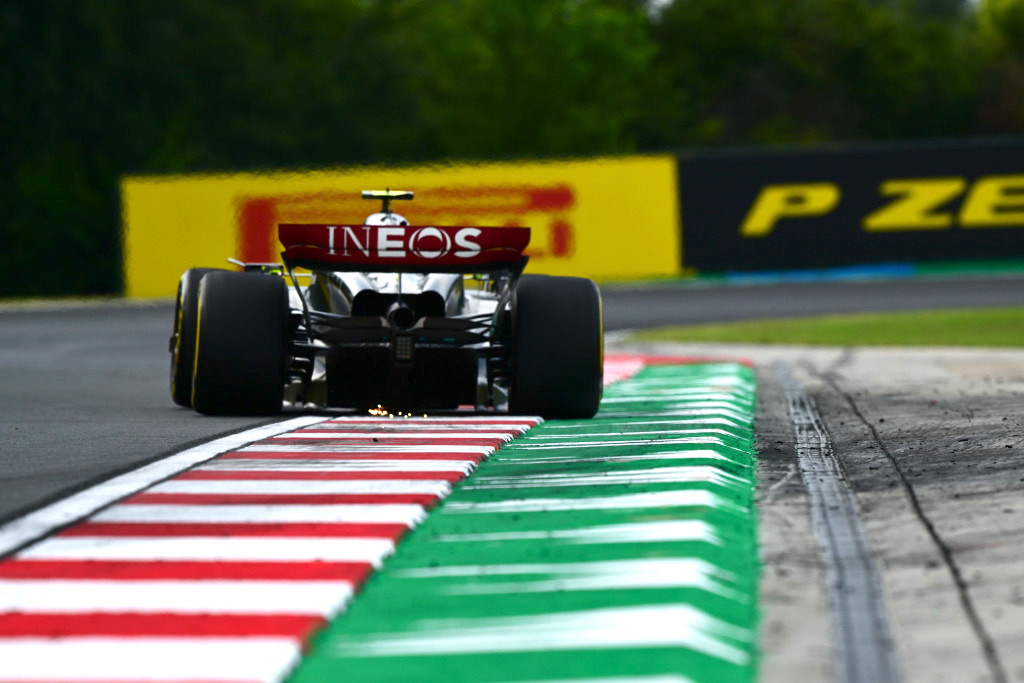Lewis Hamilton says his Mercedes car was “at its worst” on a difficult Friday afternoon at the Hungarian Grand Prix but apportioned some of the blame to Formula 1’s experimental tire rules in operation this weekend.
Hamilton finished the day an uncompetitive 16th and 1.06s off the pace. Teammate George Russell was last and 1.489s adrift.
Pirelli has temporarily reduced the number of sets of dry-weather tires available for each driver from 13 to 11 in a push to improve its environmental footprint and create more strategic jeopardy. Rather than the usual two hards, three mediums and eight softs available, each driver has been allocated three hards, four mediums and four softs.
One set of each compound must be reserved for qualifying, and one set apiece of the hards and mediums must be kept aside for the grand prix, further reducing the usable rubber stockpile for practice.
Mercedes took the unique approach of using just one set of used mediums in FP2 for each of its drivers to ensure both had more tires to choose from later in the weekend.
[lawrence-auto-related count=3 category=1388]
Hamilton lamented the reduced track time that came as an unintended consequence of the rule tweak, particularly for trackside spectators, who were treated to less action than they might have expected.
“It’s not really a great format, this change they made for this weekend,” he said. “It just means we get less running, so not ideal.
“There’s a lot of wet tires I think they throw away after every weekend — a lot. Maybe they should look at something like that rather than taking time on track away from the fans.”
The lack of track time left Hamilton unsatisfied with where his W14 ended up on Friday night, forcing him to pin his hopes for a turnaround on overnight analysis.
“It wasn’t feeling good at all. It was feeling like the car at its worst today,” he said. “But we’ll work on the setup tonight.
“Usually last year it felt terrible at the beginning and then we turned it around with some setup changes, so we’ll work on it tonight, and hopefully tomorrow will be better.”
Teammate Russell was more optimistic about Mercedes’s position given the team’s unrepresentative run plan. Most other drivers got at least a short stint on softs, exaggerating the gap.
“It didn’t feel too bad, in all honesty,” he said. “We were obviously on very different programs to everybody else … so the lap times won’t really give a true representation.
“I’m sure tomorrow will be better. We’re still just focused on trying to improve. We always know we tend to get better as the weekend progresses, which is the right way around for it to be.
“There were a few interesting things we learned even in that one session. Let’s see what we can do tonight.”
Still, Russell acknowledged Mercedes’s pace problem stemmed from an inability to get the most from its tires, which relates back to the lack of track time.
“We’re struggling just with a bit of overall grip, really,” he said. “We never got the tires in the right window both in low fuel and high fuel.
“We just need to understand why that was — if we need to be taking a faster out-lap, a slower out-lap for the qualifying stint, [or] for the race run if we need to be pushing harder, managing more.
“It wasn’t our best day for sure, but it’s not the first time I’ve said that on a Friday evening, and Saturday and Sunday are often better.”
